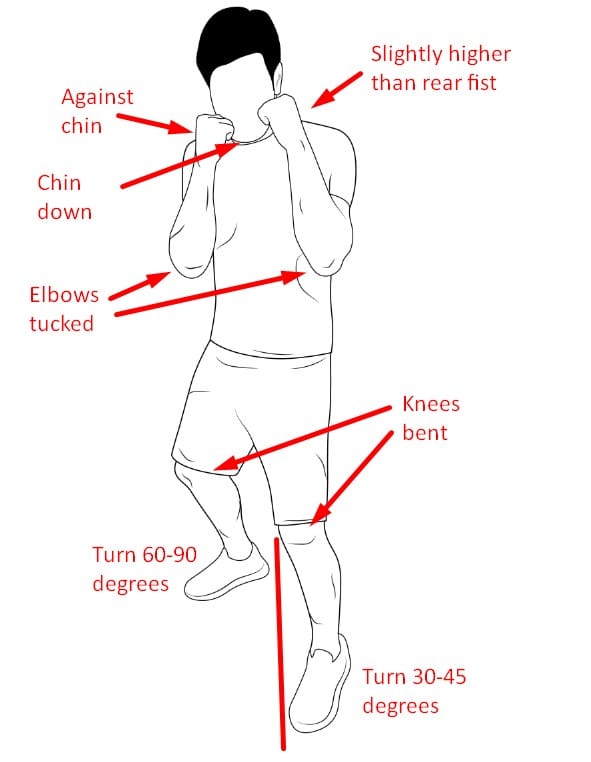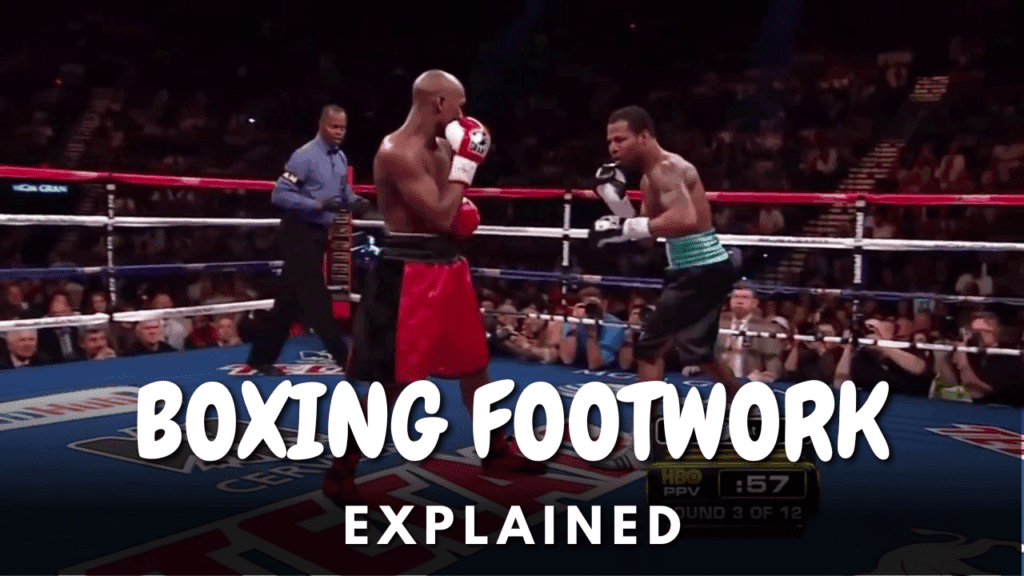A proper boxing stance is the foundation of everything you do in the ring. I remember my first day at the boxing gym – my coach spent spent so much time just helping me perfect my stance. At the time, I thought we were wasting precious punching time. Years later, I understand why: without a proper stance, it doesn’t matter how hard you can punch, you will still lose fights.
Let’s break this down into actionable steps that will set you up for success.
The Proper Boxing Stance: Full Guide
Before we dive into the specifics, let’s quickly understand what makes a proper boxing stance. Your stance needs to accomplish three key things: protect you from attacks, position you to strike effectively, and allow you to move quickly in any direction. When done right, it should feel both comfortable and powerful – like you’re ready to spring into action at any moment.

Starting Position
Start by standing tall with your feet shoulder-width apart, weight evenly distributed, and arms hanging naturally at your sides. This is your foundation. From here, we’ll build your perfect boxing stance step by step.
Foot Positioning
Step forward with your non-dominant foot (usually left for right-handed people). Keep your feet about shoulder-width apart – not so wide that you’re stuck in place, but wide enough to maintain balance.
Raise your back heel slightly off the ground and turn your front foot inward at roughly 45 degrees. Your back foot’s position is crucial – it’s your power source for those big punches. Turn it inward for about 60 degrees.
Lower Body Setup
Now bend your knees slightly, keeping your weight on the balls of your feet. Think “athletic position” – like you’re ready to move in any direction. Your front leg should be relatively straight but not locked, while your back leg stays slightly more bent. This creates a stable base for your movement and power.

Read Next: Full Guide to Boxing Footwork
Upper Body Alignment
Turn your upper body slightly to the side, so you can get that rotation with your punches later on. Keep your back straight but not stiff, and tuck your chin slightly toward your chest.
Roll your shoulders forward a bit – this creates better protection for your chin and sets you up for faster punches.
Hand Position
Bring both hands up to protect your face. Your lead hand (matching your front foot) should be slightly forward, while your rear hand stays close to your chin. Keep your elbows tucked against your ribs to protect your body.
Make loose fists – no need to clench them tightly until you’re actually throwing punches. If you’re tense, your punches will automatically be slower and less precise.

Orthodox vs Southpaw: Quick Guide
Your natural boxing stance depends on your dominant hand. Right-handed fighters typically use an orthodox stance (left foot and hand forward), while lefties use a southpaw stance (right foot and hand forward). Each has its advantages, but what matters most is choosing the one that feels natural to you.
And there you have it, you have found the proper boxing stance.
I’ve recently created a detailed video breaking down various stance variations, including the Philly Shell and other advanced techniques. You can find it on my YouTube channel along with other boxing fundamentals. For now, let’s focus on mastering the basics.
Common Mistakes and How to Fix Them
Through years of training, I’ve noticed several common issues that can hold beginners back. Watch out for:
- Standing too wide or narrow – this compromises your balance and mobility
- Dropping your hands – a dangerous habit that leaves your face vulnerable
- Standing flat-footed – makes it harder to move quickly and maintain balance
- Poor weight distribution – leads to weak punches and slow movement
The fix? Practice these fundamentals:
Start with 5 minutes of mirror work each session. Get into your stance and check each position point by point. Practice moving while maintaining this form – forward, backward, and side-to-side. Shadow box for 3 rounds, focusing on keeping your hands up and staying on the balls of your feet.
Making It Work: Training Tips
Dedicate at least a few minutes of each training session to light, technical shadowboxing. Start with basic movements: forwards, backwards, and side-to-side. Once comfortable, add in basic punches while maintaining proper form. Remember, it’s better to move slowly with perfect form than quickly with poor technique.
Read More: How to Start Shadow Boxing Training at Home
Try this simple drill: Stand in your stance and practice shifting weight between your feet while maintaining position. Close your eyes briefly to test your balance. Add light punches while focusing on keeping your stance solid.
A proper boxing stance should feel natural and comfortable once you’ve practiced it enough. If something feels off, it probably is – adjust until you find the sweet spot between stability and mobility.
Remember, every boxer’s stance will look slightly different based on their body type and fighting style. The key is to master these fundamentals and then adapt them to what works best for you. Stay patient, keep practicing, and you’ll develop a rock-solid foundation for your boxing journey.
Many beginners rush through learning their stance, eager to get to the “exciting” parts of boxing. But take it from someone who’s been there – investing time in perfecting your stance now will make everything else in boxing easier later. A proper stance makes your punches stronger, your defense tighter, and your movement smoother.
Now get out there and practice – your future self will thank you for putting in the work today!




Pingback: Top 7 Boxing Defense Drills You Can Practice Anywhere
Pingback: 6 Types of Boxing Guards to Level Up Your Game
Pingback: 7 Boxing Sparring Tips That Work Your First Time in the Ring
Pingback: How to Throw a Punch: Master Boxing Technique Like a Pro